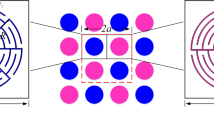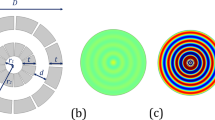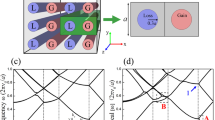Abstract
In causal physics, the causal Green’s function describes the radiation of a point source. Its counterpart, the anti-causal Green’s function, depicts a spherically converging wave. However, in free space, any converging wave must be followed by a diverging one. Their interference gives rise to the diffraction limit that constrains the smallest possible dimension of a wave’s focal spot in free space, which is half the wavelength. Here, we show with three-dimensional acoustic experiments that we can realize a stand-alone anti-causal Green’s function in a large portion of space up to a subwavelength distance from the focus point by introducing a near-perfect absorber for spherical waves at the focus. We build this subwavelength absorber based on membrane-type acoustic metamaterial, and experimentally demonstrate focusing of spherical waves beyond the diffraction limit.
This is a preview of subscription content, access via your institution
Access options
Access Nature and 54 other Nature Portfolio journals
Get Nature+, our best-value online-access subscription
$29.99 / 30 days
cancel any time
Subscribe to this journal
Receive 12 print issues and online access
$209.00 per year
only $17.42 per issue
Buy this article
- Purchase on Springer Link
- Instant access to full article PDF
Prices may be subject to local taxes which are calculated during checkout




Similar content being viewed by others
References
Feynman, R. P., Leighton, R. B. & Sands, M. The Feynman Lectures on Physics Vol. II (Basic Books, New York, NY, 2011).
de Rosny, J. & Fink, M. Overcoming the diffraction limit in wave physics using a time-reversal mirror and a novel acoustic sink. Phys. Rev. Lett. 89, 124301 (2002).
Noh, H., Popoff, S. M. & Cao, H. Broadband subwavelength focusing of light using a passive sink. Opt. Express 21, 17435–17446 (2013).
Maznev, A. A. & Wright, O. B. Upholding the diffraction limit in the focusing of light and sound. Wave Motion 68, 182–189 (2017).
Pendry, J. B. Negative refraction makes a perfect lens. Phys. Rev. Lett. 85, 3966 (2000).
Kaina, N., Lemoult, F., Fink, M. & Lerosey, G. Negative refractive index and acoustic superlens from multiple scattering in single negative metamaterials. Nature 525, 77–81 (2015).
Li, J., Fok, L., Yin, X., Bartal, G. & Zhang, X. Experimental demonstration of an acoustic magnifying hyperlens. Nat. Mater. 8, 931–934 (2009).
Shen, C. et al. Broadband acoustic hyperbolic metamaterial. Phys. Rev. Lett. 115, 254301 (2015).
Lemoult, F., Lerosey, G., de Rosny, J. & Fink, M. Resonant metalenses for breaking the diffraction barrier. Phys. Rev. Lett. 104, 203901 (2010).
Zhu, J. et al. A holey-structured metamaterial for acoustic deep-subwavelength imaging. Nat. Phys. 7, 52–55 (2011).
Fink, M. Time reversed acoustics. Phys. Today 50, 34–40 (2008).
Yon, S., Tanter, M. & Fink, M. Sound focusing in rooms: The time-reversal approach. J. Acoust. Soc. Am. 113, 1533–1543 (2003).
Jackson, J. D. Classical Electrodynamics (Wiley, New York, NY, 2007).
Cummer, S. A., Christensen, J. SpringerAmpamp; Alù, A. Controlling sound with acoustic metamaterials. Nat. Rev. Mater. 1, 16001 (2016).
Ma, G. & Sheng, P. Acoustic metamaterials: From local resonances to broad horizons. Sci. Adv. 2, e1501595 (2016).
Ma, G., Yang, M., Xiao, S., Yang, Z. & Sheng, P. Acoustic metasurface with hybrid resonances. Nat. Mater. 13, 873–878 (2014).
Mei, J. et al. Dark acoustic metamaterials as super absorber for low-frequency sound. Nat. Commun. 3, 756 (2012).
Li, Y. & Assouar, B. M. Acoustic metasurface-based perfect absorber with deep subwavelength thickness. Appl. Phys. Lett. 108, 063502 (2016).
Yang, M., Chen, S., Fu, C. & Sheng, P. Optimal sound-absorbing structures. Mater. Horiz. 4, 673–680 (2017).
Cai, X., Guo, Q., Hu, G. & Yang, J. Ultrathin low-frequency sound absorbing panels based on coplanar spiral tubes or coplanar Helmholtz resonators. Appl. Phys. Lett. 105, 121901 (2014).
Leroy, V. et al. Superabsorption of acoustic waves with bubble metascreens. Phys. Rev. B 91, 020301 (2015).
Fink, M. et al. Time-reversed acoustics. Rep. Prog. Phys. 63, 1933–1995 (2000).
Leonhardt, U. Perfect imaging without negative refraction. New J. Phys. 11, 093040 (2009).
Ma, Y. G., Sahebdivan, S., Ong, C., Tyc, T. & Leonhardt, U. Evidence for subwavelength imaging with positive refraction. New J. Phys. 13, 033016 (2011).
Tyc, T. & Zhang, X. Perfect lenses in focus. Nature 480, 42–43 (2011).
Fink, M., de Rosny, J., Lerosey, G. & Tourin, A. Time-reversed waves and super-resolution. C. R. Phys. 10, 447–463 (2009).
Draeger, C. & Fink, M. One-channel time reversal of elastic waves in a chaotic 2D-silicon cavity. Phys. Rev. Lett. 79, 407–410 (1997).
Lerosey, G. et al. Time reversal of electromagnetic waves. Phys. Rev. Lett. 92, 193904 (2004).
Przadka, A. et al. Time reversal of water waves. Phys. Rev. Lett. 109, 064501 (2012).
Chong, Y. D., Ge, L., Cao, H. & Stone, A. D. Coherent perfect absorbers: time-reversed lasers. Phys. Rev. Lett. 105, 053901 (2010).
Wan, W. et al. Time-reversed lasing and interferometric control of absorption. Science 331, 889–892 (2011).
Li, S. et al. Broadband perfect absorption of ultrathin conductive films with coherent illumination: Superabsorption of microwave radiation. Phys. Rev. B 91, 220301 (2015).
Meng, C., Zhang, X., Tang, S. T., Yang, M. & Yang, Z. Acoustic coherent perfect absorbers as sensitive null detectors. Sci. Rep. 7, 43574 (2017).
Pirruccio, G., Martín Moreno, L., Lozano, G. & Gómez Rivas, J. Coherent and broadband enhanced optical absorption in graphene. ACS Nano 7, 4810–4817 (2013).
Brunet, T. et al. Soft 3D acoustic metamaterial with negative index. Nat. Mater. 14, 384–388 (2014).
Assous, F., Kray, M., Nataf, F. & Turkel, E. Time-reversed absorbing condition: application to inverse problems. Inverse Probl. 27, 065003 (2011).
Kuttruff, H. Room Acoustics (Taylor & Francis, New York, NY, 2009).
Acknowledgements
G.M. and P.S. acknowledge the support of the Hong Kong Research Grants Council (grant no. AoE/P-02/12). J.d.R and M.F. acknowledge LABEX WIFI (Laboratory of Excellence within the French Program Investments for the Future) under references ANR-10-LABX-24 and ANR-10-IDEX-0001-02 PSL*.
Author information
Authors and Affiliations
Contributions
M.F., G.M. and P.S. supervised the research. G.M. designed the experiment with the help of J.d.R. X.F. and G.M. carried out the experiment. F.M. performed experiments at the early stage of this project. All authors were involved in discussion and analysis of data. G.M., P.S. and M.F. prepared the manuscript.
Corresponding authors
Ethics declarations
Competing interests
The authors declare no competing interests.
Additional information
Publisher’s note: Springer Nature remains neutral with regard to jurisdictional claims in published maps and institutional affiliations.
Supplementary information
Supplementary Information
Supplementary Note, Supplementary Figures 1–5, References
Rights and permissions
About this article
Cite this article
Ma, G., Fan, X., Ma, F. et al. Towards anti-causal Green’s function for three-dimensional sub-diffraction focusing. Nature Phys 14, 608–612 (2018). https://doi.org/10.1038/s41567-018-0082-3
Received:
Accepted:
Published:
Issue Date:
DOI: https://doi.org/10.1038/s41567-018-0082-3
This article is cited by
-
Simulation of the Sub-Wavelength Focusing Capability of Cylindrical Concave Phased Array
Journal of Medical and Biological Engineering (2022)
-
Superbroad-band actively tunable acoustic metamaterials driven from poly (ethylene terephthalate)/Carbon nanotube nanocomposite membranes
Nano Research (2021)
-
Practical realization of a sub-λ/2 acoustic jet
Scientific Reports (2019)



